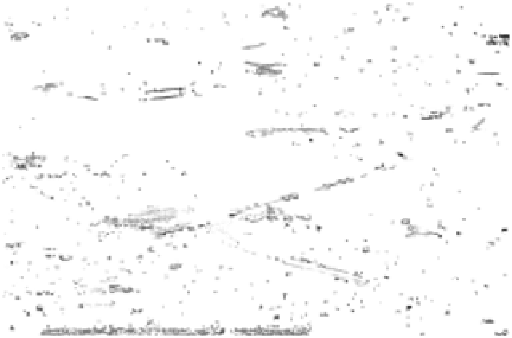Environmental Engineering Reference
In-Depth Information
FIGURE 26.6
Elephant Butte Dam. (Courtesy of the U.S. Bureau of Reclamation.)
TABLE 26.2
Dams of the Southwest
Southwest Dam
Data
Fact
Elephant Butte Dam
Hoover Dam
Roosevelt Dam
Constructed
1912-1916
1931-1936
1903-1911
River system
Rio Grande
Colorado
Salt
Storage capacity
2,109,423 ac ft
28,537,000 ac ft
2,910,200 ac ft
Height
301 ft
726.4 ft
356 ft
Crest length
1,674 ft
1,244 ft
723 ft
Crest elevation
4,414 ft
1,232 ft
2,218 ft
Concrete used
629,500 yd
3
3,250,000 yd
3
606,000 yd
3
Drainage area
28,900 mile
2
167,800 mile
2
5,830 mile
2
Source:
U.S. Bureau of Reclamation. http://www.usbr.gov/dataweb/dams.
In spite of the successes of the Roosevelt, Elephant Butte, and Hoover Dams, central
Arizona was left without a permanent water solution (Table 26.2). A dam project was
proposed in Tucson at Sabino Canyon in 1936 and received widespread support until the
Army Corps of Engineers put the local contribution for the dam construction at $500,000.
The political leaders at this time were not able to muster the financial backing within the
community, and the idea of banking water in southern Arizona was tabled. Inaction on
dealing with the larger water problem in Tucson left the region with no choice other than to
rely on groundwater pumping for the foreseeable future. Some relief was on the way, how-
ever, with a long-awaited construction of the Central Arizona Project (CAP), a multibillion
dollar federal project that would divert Colorado River water into central and southern
Arizona. The CAP took many decades to become a completed project (Figure 26.7).
The CAP was originally proposed in 1947 but was not authorized until 1968 due to
disagreements on the merits of this project with other regional stakeholders. Political
wrangling over appropriation of funds ensued in the years following the authorization of
the CAP. The debate over the CAP forced the enactment of the broad-sweeping Arizona









Search WWH ::

Custom Search